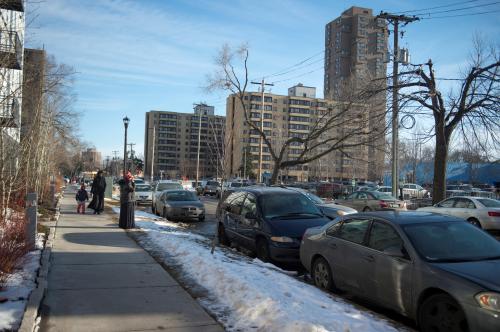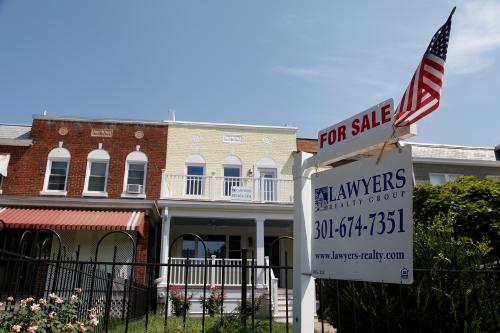Since the Great Recession, the share of U.S. households who rent their homes has increased from 32 percent to 36 percent. Rents have risen faster than incomes; nearly half of renter households now spend more than 30 percent of their income on housing. The increasing financial stress faced by middle-income renters is drawing political attention, along with heated debates over what policy changes could help, from just-cause eviction laws to national rent control. Before exploring radical options, there is a simpler tweak that could improve renters’ stability and financial well-being: expanding the use of longer-term leases.
Moving is expensive. Long-term leases could save renters and landlords money.
Moving from one home to another is stressful, disruptive, and expensive. Searching out a new place to live, packing and unpacking one’s possessions takes time. The out-of-pocket costs — hiring movers, paying application fees, security deposits, and utility connections – can quickly add up. Relocating to another neighborhood requires countless adjustments to daily habits, such as navigating new commuting routes and finding convenient shops.
Tenant turnover is costly for landlords too. When an existing tenant moves out, the landlord incurs costs from cleaning and repairing the unit, marketing it to new tenants, and screening applicants. Any time that apartments sit vacant is lost rent for landlords. Vacancies are particularly tough for owners of small apartment buildings: when half a duplex sits empty, that means a 50% drop in revenue. As of 2018, roughly half of all rental units were in 1-to-4 family buildings.
Despite high costs of moving to both landlords and tenants, most residential leases in the U.S. only run for one year. Multiyear leases are the norm for commercial real estate, such as retail and office. Residential leases lasting for several years are fairly common in Germany and Japan. While raises the question: is there unmet demand in the U.S. apartment market for multiyear leases?
Many renters stay in the same home for extended periods of time (Figure 1). Almost half of all renters stay in their home for three or more years, and one in five stay for 8 or more years. A survey by the National Multifamily Housing Council found that about one-third of current renters would prefer a lease term lasting more than one year. While not all long-term renters would want to commit to multiyear leases, the data suggest there may be a market for leases with durations of 2 to 5 years.
Multiyear leases offer potential benefits – and some risks — to landlords and tenants
Whether landlords and tenants prefer short- or long-term leases depends in part on their expectations of local housing market conditions. Renters benefit most from signing long-term leases with pre-set rents when their local housing market is getting tighter, with declining vacancy rates and increasing rents. Conversely, when local housing markets are softening, renters may prefer to keep their options open, allowing them the possibility to move to a higher-quality apartment, a better location, or to negotiate a lower rent on their current home.

For landlords, these incentives are exactly flipped. Landlords would most want to offer long-term leases when they expect stable or declining rents in the local area. Softer housing markets also increase the likelihood that, when the current tenant moves out, the apartment will sit vacant for longer; long-term leases offer landlords insurance against lost income.
The inverted incentive structure in this situation mirrors another type of housing contract: interest rate risk assumed by borrowers and lenders when signing a mortgage. Borrowers who take out fixed-rate mortgages are protected from interest rates rising over time; even when rates increase, their monthly payments do not. Banks worry that, when interest rates drop, a slew of borrowers will refinance their loans to lower rates, costing the lenders. (The Dodd-Frank Act restricted the use of prepayment penalties, which were mainly used in the subprime mortgage market, to discourage borrowers from refinancing when rates drop.)
Mortgage markets offer an example of how to split risk between borrowers and lenders: adjustable-rate mortgages (ARMs) that can increase or decrease over time, linked to some benchmark index. Residential leases could incorporate similar mechanisms so that neither landlord nor tenant bears the entire risk of rising (or declining) market rents. This technique is already used by some multi-year commercial leases, while others include pre-determined “step-up” rents (rents can only adjust upward, but by a known amount).
One important consideration for long-term leases is how mechanisms are designed for either side to terminate the lease early. A multiyear lease will have higher likelihood of unexpected situations arising during the lease’s duration; tenants want to relocate to another city for work, or a mom-and-pop landlord needs capital and wants to sell the housing unit. Both parties need clearly stipulated terms for how much advance notice must be given, and any financial penalties for early termination should be spelled out. And while multi-year leases provide greater stability for tenants who comply with their lease terms, landlords must still retain the right to remove problematic tenants, to protect the health and safety of other tenants in the building.
Homebuyers receive more federal consumer protection than renters.
The federal government plays a much more active role in regulating mortgage markets for owner-occupied housing than it does in rental housing – even though renters generally are poorer than homeowners. State governments have more responsibility for regulating rental markets, creating considerable state-by-state variation in tenant protections. There are three types of consumer protections that the federal government currently provides to homebuyers that could be replicated to better protect renters.
Require more consistency and transparency of leases
Like mortgages, residential leases are often long, complex legal documents that may be difficult for renters to review and understand. After the foreclosure crisis, the federal government adopted new regulations designed to restrict certain risky loan characteristics and provide consumers with more transparent information about their loan terms. Leases, which are regulated by state rather than federal law, can vary widely and are not vetted for clarity. More transparency would help level the field between landlords and renters.
Allow renters to “shop” for leases independently from apartments
Prospective homebuyers can select the housing unit they wish to inhabit separately from choosing their preferred mortgage terms (and lender). For renters, the lease terms, landlord, and housing unit are generally bundled. Renter could receive information about lease options from a neutral third party, similar to a housing counseling organization, that does not represent the landlord’s financial interest.
Increased resources for enforcing fair housing laws
One potential concern about expanding multi-year leases is that landlords may prefer to offer these to the prospective tenants with higher income and credit scores, while “screening” out tenants they perceive as higher risk (those with less stable employment or single parents with small children). Increased resources for fair housing enforcement, such as audit studies used to catch steering by realtors, would help reduce the likelihood of adverse screening.
Better leases are only the first step towards better housing markets
Better leases will not solve all the underlying problems in housing markets. In communities with tight regulatory restrictions, there simply isn’t enough rental housing being created to accommodate increased demand. Poor families earn too little income to cover operating expenses of market-rate apartments without government subsidy. But encouraging leases that more fairly balance risk between landlords and tenants, and making lease terms more transparent, would help make renting a more stable choice for middle-income households.
Thanks to Tiffany Ford for excellent research assistance.
The Brookings Institution is committed to quality, independence, and impact.
We are supported by a diverse array of funders. In line with our values and policies, each Brookings publication represents the sole views of its author(s).







Commentary
Offering renters longer leases could improve their financial health and happiness
February 19, 2020